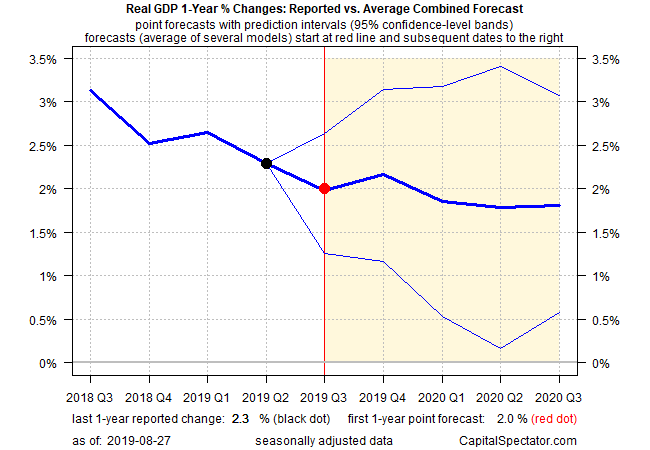Modest Growth Still Expected For US Economy In Q3
The uncertainty with the US-China trade war continues to roil financial markets and business sentiment, but the outlook for the upcoming third-quarter US GDP report is still pointing to moderate growth, based on the latest nowcasts. The chaotic trade negotiations led by President Trump aren’t helping, but the best-guess of several widely followed models remain relatively upbeat.
A revised set of estimates anticipate that US output will rise 2.0% in the July-through-September period, according to the median for several nowcasts compiled by The Capital Spectator (see chart below). That’s up fractionally from the 1.9% estimate from early August. A 2.0% rise is also in line with the 2.1% increase reported for Q2.

The American economy appears resilient in the face of trade uncertainty, but the headwinds in the global economy are building and therefore worrisome. Notably, Germany appears to be in recession. Europe’s biggest economy reported that output contracted in Q2, raising fears that the already weak trend in the eurozone may soon falter. Britain’s economy also slipped in Q2 and the escalation in the trade war is weighing on China’s economy, which recently reported that industrial production growth decelerated to slowest pace in 30 years.
Driving the potential for a global slowdown if not a recession is the escalating trade war between the US and China. “We view risks of further escalation as meaningful,” warns the chief economist at Morgan Stanley. Writing in a note to clients earlier this week, Chetan Ahya advised that “if the US raises tariffs on all imports from China to 25% and China makes a matching response, with those measures staying in place for four to six months, we believe that the global economy will be in recession in six to nine months.”
But a lot can happen in six to nine months. Actually, a 24-hour news cycle with Donald Trump can make an analyst’s head spin, as the president’s comments at the G-7 meeting in recent days reminds. As Bloomberg notes:
President Donald Trump left the G-7 summit on Monday taking a softer tone toward China, just days after spooking financial markets with another escalation in their trade war. Yet amid all the soothing words, Trump made it clear that he wasn’t abandoning his rough and tumble
tactics to force a trade deal on China.
Trying to make sense of the economic implications from Trump’s public comments and tweets may be a hopeless task, but for now, the near-term outlook remains positive, albeit with a downside bias. Today’s revised GDP point forecast projects that the year-over-year rate of growth will mostly ease in the quarters ahead, based on The Capital Spectator’s average estimate from a set of combination forecasts.

The good news is that US expansion appears set to roll on in Q3. Looking further out is a guessing game, more so than usual. The main challenge: Until the US-China trade conflict is resolved (or at least tamed), the potential for negative surprises will continue to lurk.
“For the rest of the world, there are many other countries that are innocent bystanders that will actually suffer even more than the United States and China,” observes Louis Kuijs, head of Asia economics at Oxford Economics in Hong Kong. “There is not going to be any de-escalation [in the trade war] any time soon,” he predicts.
Disclosure: None.



